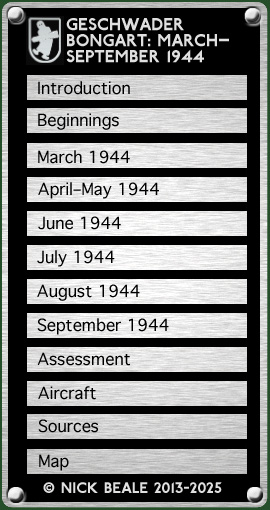|
Compounding the Germans’ desperate situation, the new Ob. West, Generalfeldmarschall Walter Model, passed on the following order from OKW: The increased acuteness of the aircraft fuel situation has now forced OKL to decree far-reaching limitations for GAF operations at the front also … Only fighter operations in air defence to continue without limitation. Reconnaissance can only be carried out within the limits of what is absolutely necessary. Support of the Army by bomber and ground attack operations is possible only in decisive operations. Luftwaffe authorities have received similar instructions from OKL. The aircraft fuel situation is to be taken into account in requests submitted to the Luftwaffe. At 08.10 hrs. three JGr. 200 machines again took off for Vallon, to make mortar attacks on guerillas. This seems to have been the Jagdgruppe’s final air-to-ground mission. One of the He 111s shot down by US Navy Hellcats that afternoon has been linked by researcher Paul Mathevet to a twin-engined aircraft which had been shooting up resistance fighters on the heights above Mauves (in the Ardèche, overlooking the Rhône Valley north of Valence). The German machine exploded on impact, five bodies were retrieved and buried by the crash site. Geschwader Bongart lost two aircraft: a W. 34 of the 7. Staffel and a W. 34 hi (W.Nr. 443, SA+FS) of the 8. The five men aboard were all reported missing and none appears in the German War Graves database. They were Uffz. Wilhem Stark (pilot), Ogefr. Karl Blum (flight mechanic), Ofw. Karl Zobe (pilot), Ogefr. Hans Ploep (flight mechanic) and Uffz. Max Thiel (flight mechanic of the 12. Staffel).
20 August At 18.00 hrs. Luftlfotte 3 directed Bongart to get ready for a transfer of “all elements” to Luxeuil but to await the actual order before moving. Five days later however the Geschwaderkommodore reported from Luxeuil that he had evacuated Clermont-Ferrand on the 20th because: 1) The Fliegerhorstkommandantur had received orders for immediate demolition and had already begun to carry them out. 2) Aircraft serviceability states had sunk too low. 3) The Geschwader’s transport situation would not permit a sudden transfer without great loss of material. It was not only the Luftwaffe that was being evacuated from Clermont-Ferrand; the Military Commander for Southern France ordered that 40,000 million Francs in the city’s Banque de France must be “secured at all costs” and removed to Nancy. The Maquis Bernard's vehicle park at Ouroux-en-Morvan was again bombed by German aircraft during the evening, while in Lamastre two large bombs falling in the river bed caused no casualties. Nor was there any serious damage done when Saint-Georges-les-Bains was bombed. These were last German air attacks in the Ardèche before the Luftwaffe evacuated Valence aerodrome. Historian Guy Mathevet puts the cost to the region at 28 dead, 48 injured and 127 buildings destroyed or seriously damaged. 22 August Grenoble was liberated but 30 km to the west, five German aircraft swept over the town of Saint Marcellin, late in the afternoon, dropping bombs and strafing. According to an eyewitness, they were preparing for a second pass when they were driven off by three British fighters. Three bombs fell where they could do material damage, injuring 25 people of whom nine later died.
Early in the morning a spotter aircraft overflew the positions of the Lomont Maquis (19 km west of Belfort), the prelude to an assault that evening by German ground forces. The base commandant at Luxeuil (signing as “Edzert” but possibly Oberst Cornelius Edzard) advised Clermont-Ferrand that he was ready to receive their Fliegerhorstkommandantur and when would they be arriving? At 13.00 hrs. the Kapitän of 4.(F)/123, Oblt. Werner Kohla issued a preliminary order: Get ready two aircraft with cameras and auxiliary tanks for task P/R airfield Bourges … airfield Avord … Clermont-Ferrand … Lyon-Bron … All airfields with runway. Intermediate landing according fuel reserves at Lyon or Dijon. Fill up there and bring films to Reims. Pilots: Fw. Schuster, Uffz. Henkel. Greatest urgency. Ofw. Holbartz will bring full orders. The reason for covering these airfields is not immediately obvious. German-occupied Central France was threatened but Clermont-Ferrand would not be freed until the 27th; Lyon would be in German hands for another 10 days; and Bourges was only liberated on 6 September. 23 August A Hptm. Stoßberg told the Geschwader to return Uffz. Grezens and his serviceable Ju 88 to Lyon right away. 25 August This is the first time that the Maquis goes over to the attack. Hitherto they only used to fire from ambush, then withdraw. I./Sicherungs Regiment (mot.) 1000 In his report to Luftlfotte 3’s Chief of Staff, Oberst Bongart explained the steps he had taken since quitting Clermont-Ferrand five days earlier. The 8. Staffel in Lyon had been reinforced with 15 Re. 2002 and 2 Ju 88, enabling operations in the “southern area” to be maintained. Reconnaissance and combat operations against “terrorists” near Saint-Yan were being carried out from Luxeuil, since it had been necessary to evacuate Lyon on the 24th. SS-Oberführer Johannes Bernhardt had been freed by ground units, so the Geschwader had not needed to intervene (the inference is that it had been called on to support this action).
To maintain operational readiness and “bring about [its] absolutely necessary improvement”, at minimum the Geschwader needed one motorised airfield servicing company for the Ju 88 and a servicing platoon for the Bf 109 and Fw 190. Bongart also called for the allocation of a base workshop, especially for the Ju 88. continued on next page …
|
|||||

